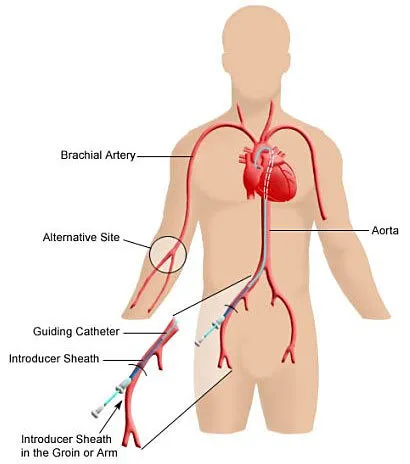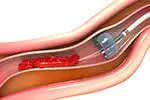Cardiac Catheterization Laboratory (Cath Lab)
A cardiac catheterization lab, also known as a “cardiac cath lab,” is a specialized area in the hospital where doctors perform minimally invasive tests and advanced cardiac procedures to diagnose and treat cardiovascular disease. The cardiac cath lab is equipped with state-of-the-art imaging technology used to view the arteries and check how well blood is flowing to and from the heart. This provides the care team with information to help diagnose and treat blockages and other problems in the arteries often without patients needing to undergo surgery.
The Cardiac Catheterization Laboratory (Cath Lab) at San Antonio Regional Hospital provides 24-hour coverage by an expert team of board-certified interventional cardiologists, nurses, and radiology technicians who have special training in a variety of invasive diagnostic and interventional cardiac procedures.
The cardiac catheterization procedure itself involves threading a long, thin tube, called a catheter, through an artery or vein in the leg or arm and into the heart. Sometimes a cardiac catheterization is performed due to an emergency such as a heart attack in progress. Other times, a cardiac catheterization, also known as an angiogram, is performed as a diagnostic tool to check for blockages if your physician suspects you may have coronary artery disease.
San Antonio Regional Hospital’s Heart Institute is known for outstanding performance in treating a specific heart attack known as ST-elevation myocardial infarction (STEMI).
 STEMIs are caused by a sudden blockage in a coronary artery and recent studies have indicated that rapid cardiac intervention is the most effective treatment for saving the heart muscle. Patients may be brought into the cardiac cath lab 24 hours a day, 7 days a week where these blockages can be immediately opened by using a balloon catheter and/or implanted stent.
STEMIs are caused by a sudden blockage in a coronary artery and recent studies have indicated that rapid cardiac intervention is the most effective treatment for saving the heart muscle. Patients may be brought into the cardiac cath lab 24 hours a day, 7 days a week where these blockages can be immediately opened by using a balloon catheter and/or implanted stent.
“Door-to-balloon” or “door to reperfusion” time is the measurement of time starting when a patient arrives in the Emergency Department, to the time when the blockage in the coronary artery causing the STEMI is opened with a balloon angioplasty, or a stent in the Cardiac Catheterization Lab. Every minute counts to help save heart muscle.
Routine procedures at San Antonio Regional Hospital’s Cardiac Catheterization Lab are scheduled weekdays, from 7:30 am to 6:00 pm, by your physician’s office staff. Emergency cardiac diagnostic, interventional, and therapeutic procedures are available at all times.
Cardiac Catheterization/Angiogram
A cardiac catheterization or angiogram, is a medical procedure that provides detailed x-ray images of your heart and its blood vessels and is used to diagnose the presence of coronary artery disease. During the angiogram, a small, flexible tube known as a catheter is inserted into a large vessel in your upper thigh or arm, and then guided through the arteries to the heart. A special contrast dye is injected into the catheter which flows to the coronary arteries and heart. The dye shows blood flow through the arteries of the heart and the location of any blockages. An angiogram will show doctors whether blood flow is or is not being restricted to your heart. If the cardiac catheterization does show that the arteries to your heart are narrowed or blocked, the cardiac catheterization will pinpoint exactly where the blockages are located and their size — information that will enable the cardiologist to develop the best plan to treat each blockage.
Interventional Procedures
Interventional procedures are non-surgical cardiac interventions that are performed in the cardiac catheterization laboratory by a specialized cardiologist and a cardiovascular team of nurses and technologists. The procedures utilize special catheters that are used to “open” blocked arteries that supply blood to the heart.
An interventional procedure starts out in the same way as a diagnostic cardiac catheterization or angiogram. The catheter will be selectively passed into the artery with the blockage, and the doctor will perform the interventional procedure to open the blocked artery. The procedure usually lasts about 1-1/2 to 2-1/2 hours, but the preparation add additional time. An overnight stay is sometimes required.
Balloon Angioplasty
 During angioplasty in the cardiac catheterization lab, the interventional cardiologist will use a special catheter with a small angioplasty balloon attached at the end. The balloon is at one end and can be inflated from the other end outside the body. A physician trained in interventional cardiology then threads the balloon catheter over a guidewire to the area of the artery that has become blocked with the fatty substance called plaque. Plaque is what prevents your blood from flowing as it should. The balloon is inflated and deflated several times to compress the plaque or fatty matter in the artery wall and stretch the artery open to increase blood flow in the artery in the heart.
During angioplasty in the cardiac catheterization lab, the interventional cardiologist will use a special catheter with a small angioplasty balloon attached at the end. The balloon is at one end and can be inflated from the other end outside the body. A physician trained in interventional cardiology then threads the balloon catheter over a guidewire to the area of the artery that has become blocked with the fatty substance called plaque. Plaque is what prevents your blood from flowing as it should. The balloon is inflated and deflated several times to compress the plaque or fatty matter in the artery wall and stretch the artery open to increase blood flow in the artery in the heart.
Stent

A stent is used along with balloon angioplasty in the cardiac catheterization laboratory. A stent is a small, metal mesh tube that is delivered through a catheter to the site of a blocked artery and then permanently embedded within the artery. A stent acts as a tiny scaffold to prop an artery open and prevent it from collapsing or becoming re-blocked with plaque.
The stent is mounted on a balloon-tipped catheter, threaded through an artery, and positioned at the blockage. The balloon is then inflated, opening the stent. Then, the catheter and deflated balloon are removed, leaving the stent in place permanently. Depending on the number of blockages, more than one stent may be used.
Rotoblation
 A rotoblation procedure is performed in the cardiac catheterization lab. During rotoblation, a special catheter, with an acorn-shaped diamond-coated tip, is guided to the point of narrowing in the coronary artery. The tip spins around at a high rate of speed and grinds away the plaque that has built up on your artery walls and narrowed your artery. The microscopic particles are washed safely away in your blood stream and filtered out by your liver and spleen.
A rotoblation procedure is performed in the cardiac catheterization lab. During rotoblation, a special catheter, with an acorn-shaped diamond-coated tip, is guided to the point of narrowing in the coronary artery. The tip spins around at a high rate of speed and grinds away the plaque that has built up on your artery walls and narrowed your artery. The microscopic particles are washed safely away in your blood stream and filtered out by your liver and spleen.
Cutting Balloon
The cutting balloon catheter has a special balloon tip with small blades. When the balloon is inflated, the blades are activated. The small blades score the plaque and the balloon compresses the fatty matter into the artery wall, opening the narrowed artery during the cardiac catheterization procedure.
Pacemaker

Pacemaker procedures can also be done in cardiac cath labs. A pacemaker is a small device that is powered by a battery. It helps the heart beat in a regular rhythm. Pacemakers are needed for those who have a slow and irregular heart rhythm. A pacemaker is about the size of a small matchbox. The pacemaker “can” or container has two parts inside:
- A pulse generator, which includes the battery and several electronic circuits.
- Wires, called leads, which are attached to the heart wall. Depending on the type of pacemaker you need, there may be one or two leads.
The pacemaker is implanted under the skin and fatty tissue near the collarbone. If only one lead is needed, it is placed in the lower-right chamber (the right ventricle). If two leads are needed, the other lead is placed in the upper-right chamber (the right atrium). The leads are then attached to the pacemaker (pulse generator).
Once the pacemaker is implanted, the leads carry signals back from the heart. The pulse generator “reads” these signals. When the heart rate is too slow, it sends an impulse to the heart to help beat in a regular rhythm.
PAD Treatment
Vascular diseases such as Peripheral Artery Disease (PAD) may also be treated in the San Antonio Regional Hospital Cardiac Catheterization Lab by interventional cardiologists. Using imaging for guidance, the cardiologists thread a catheter through the femoral artery in the groin, to the blocked artery in the legs. Then a balloon is inflated to open the blood vessel where it is narrowed or blocked. In some cases, this is then held open with a stent, a tiny metal cylinder. This is a minimally invasive treatment that does not require surgery, just a small opening in the skin about the size of a pencil tip.
Balloon angioplasty and stenting have generally replaced invasive surgery as the first-line treatment for PAD. Studies have shown interventional therapy for PAD to be as effective as surgery for many arterial occlusions.
Heart Institute Quick Links
- Healthgrades™ 50 Best Award
- 2022 Cardiac Workshops
- 2020 Cardiac Workshops
- 2019 Cardiac Workshops
- Balloon Angioplasty
- Cardiac Arrhythmia Surgery
- Cardiac Catheterization
- Cardiac Educational Classes
- Cardiac Rehabilitation
- Cardiac Rehabilitation Outpatient
- Cardiovascular Surgery
- Coronary Artery Bypass Graft
- Coronary Artery Disease
- Coronary Artery Disease Diagnostic Testing
- ECMO
- Electrophysiology
- Heart and Cardiovascular Surgery
- Heart Rhythms Arrhythmias
- Heart Valve Repair
- Impella Left Ventricular Assist Device
- Implantable Cardioverter Defibrillator
- Off-Pump Coronary Bypass Surgery
- Pacemaker
- Peripheral Arterial Disease
- Stent Placement
- Supraventricular Tachycardia
- Transcatheter Aortic Valve Replacement (TAVR)
- Valve Disease
- Wolff Parkinson White Syndrome
